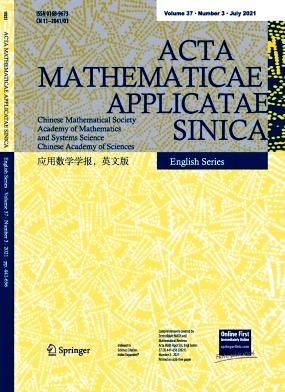无 4 循环的 1 平面图的无循环边着色
IF 0.9
4区 数学
Q3 MATHEMATICS, APPLIED
Acta Mathematicae Applicatae Sinica, English Series
Pub Date : 2024-01-03
DOI:10.1007/s10255-024-1101-z
引用次数: 0
摘要
摘要 图 G 的非循环边着色是指 G 中不存在双色循环的适当边着色。G 的非循环色度指数 \(\cal{X}_{\alpha}^{\prime}(G)\)是使 G 具有使用 k 种颜色的非循环边着色的最小 k。有人猜想,每个具有最大度 Δ 的简单图 G 都有\(\cal{X}_{alpha}^{\prime}(G)\le\Delta+2\)。1-planar graph(1-平面图)是指可以在平面上绘制的图,每条边最多与另一条边交叉。在本文中,我们证明了每一个没有 4 循环的 1-planar graph G 都有\(\cal{X}_{\alpha}^{\prime}(G)\le\Delta+22\) .本文章由计算机程序翻译,如有差异,请以英文原文为准。
Acyclic Edge Coloring of 1-planar Graphs without 4-cycles
An acyclic edge coloring of a graph G is a proper edge coloring such that there are no bichromatic cycles in G. The acyclic chromatic index \(\cal{X}_{\alpha}^{\prime}(G)\) of G is the smallest k such that G has an acyclic edge coloring using k colors. It was conjectured that every simple graph G with maximum degree Δ has \(\cal{X}_{\alpha}^{\prime}(G)\le\Delta+2\). A 1-planar graph is a graph that can be drawn in the plane so that each edge is crossed by at most one other edge. In this paper, we show that every 1-planar graph G without 4-cycles has \(\cal{X}_{\alpha}^{\prime}(G)\le\Delta+22\).
求助全文
通过发布文献求助,成功后即可免费获取论文全文。
去求助
来源期刊
CiteScore
1.30
自引率
0.00%
发文量
70
审稿时长
3.0 months
期刊介绍:
Acta Mathematicae Applicatae Sinica (English Series) is a quarterly journal established by the Chinese Mathematical Society. The journal publishes high quality research papers from all branches of applied mathematics, and particularly welcomes those from partial differential equations, computational mathematics, applied probability, mathematical finance, statistics, dynamical systems, optimization and management science.

 求助内容:
求助内容: 应助结果提醒方式:
应助结果提醒方式:


